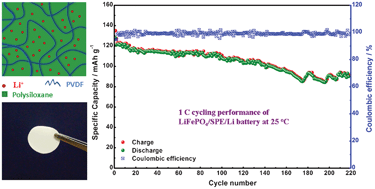A wider temperature range polymer electrolyte for all-solid-state lithium ion batteries
Abstract
We report on making a wider operating temperature solid

* Corresponding authors
a
School of Metallurgical Science and Engineering, Central South University, Changsha City, P.R. China
E-mail:
liujincsu@163.com
Fax: +86 731 88830649
We report on making a wider operating temperature solid

 Please wait while we load your content...
Something went wrong. Try again?
Please wait while we load your content...
Something went wrong. Try again?
Y. Lin, J. Li, Y. Lai, C. Yuan, Y. Cheng and J. Liu, RSC Adv., 2013, 3, 10722 DOI: 10.1039/C3RA40306H
To request permission to reproduce material from this article, please go to the Copyright Clearance Center request page.
If you are an author contributing to an RSC publication, you do not need to request permission provided correct acknowledgement is given.
If you are the author of this article, you do not need to request permission to reproduce figures and diagrams provided correct acknowledgement is given. If you want to reproduce the whole article in a third-party publication (excluding your thesis/dissertation for which permission is not required) please go to the Copyright Clearance Center request page.
Read more about how to correctly acknowledge RSC content.
 Fetching data from CrossRef.
Fetching data from CrossRef.
This may take some time to load.
Loading related content
